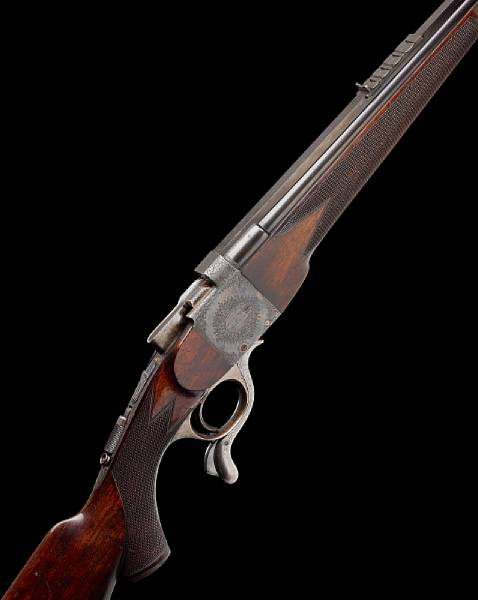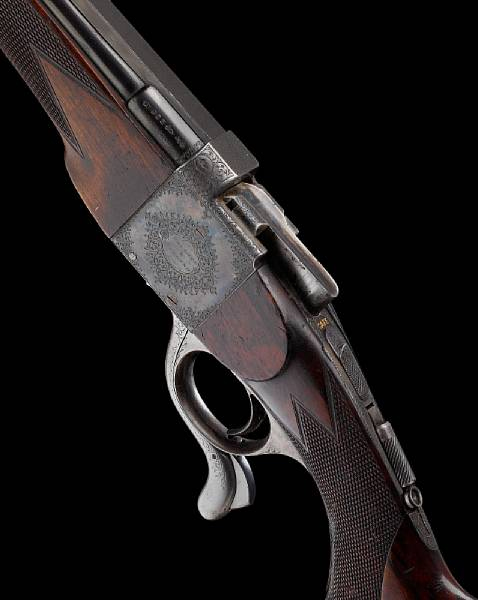CptCurl
|
| (.450 member) |
| 07/11/10 09:11 PM |

|
|
|
I think it will exceed the estimates.
Wonder how the bore is.
Curl
POST EDITED ON 11 DEC. 2010 TO INCLUDE PHOTOS AND DESCRIPTION:



A very rare Holland-Woodward patent .256 falling-block rifle by Holland & Holland, no. 21873 Built for F.C. Selous
The action using H.W. Holland & T. Woodward patent no. 17,578 of 15 September 1894, the sides of the action-body with the makers name engraved in an oval surrounded by best bold foliate-scrollwork, the underside engraved with the patent number, virtually full hardening-colour, the bright cocking-lever engraved en suite, the top-tang with shotgun-style safety and flip-up peep-sight, figured stock (minor crack at base of pistolgrip near cap) with pistolgrip, engraved pistolgrip-cap with trap containing three additional bead-foresights, cheek-piece and horn butt-plate, horn-capped forend, sling-eyes, the circular barrel with matt sight-rib, engraved Holland & Holland, 98 New Bond Street, London Winner Of All The "Field" Rifle Trials, London, 100 yard fixed-sight and leaf-sights sighted for 200, 300, 400 & 500 yards, and ramp-mounted ivory bead-foresight
Weight 7lb. 9oz., 14¾in. pull (14 3/8in. stock), 28in. barrel, London nitro proof
Sold for £32,400 inclusive of Buyer's Premium
Footnote:
The makers have kindly confirmed that the rifle was completed in 1899 for Frederick Selous. It was originally shot and regulated 'with Austrian Mannlicher Cartridges with drilled bullets', and was resighted in 1901 by Selous at the Holland & Holland range 'for own shooting'.
Literature:
Walter G. Winfer, British Single Shot Rifles, Volume 5, Rochester, 2004, pp.84-88
Thomas Woodward was born in Birmingham in 1855. Little is known of his early life, but he is probably the same man recorded as a gunmaker from 1868 through to about 1890. He was recruited by Henry Holland in 1892, moving to London to set up Holland's first factory at 527-33 Harrow Road and later supervising the move to its current address in 1898. This involved not only equipping it, but also recruiting gunmakers to staff it, and he is seen as having a large role in the company's transition after 1893 from being a primarily retail business to manufacturing its own firearms. He was also an innovative man, listed as co-patentee with Henry Holland on nineteen patents including this falling-block action, along with designs for the single-trigger (eleven in total), hand-detachable lockplates and both the Paradox and Velopex bullets. By 1904 he had been made a director of the company, a position which he was to hold until ill health forced him to resign in 1914.
Although Holland & Holland had been selling falling-block rifles since 1890, the Holland-Woodward action was the first design by the makers, and the first example was completed as a .303 in 1895 (no. 19557). Total production is believed to have been in the order of only 140 rifles, the bulk being sold between 1899 and 1901 and the last in 1926. Winfer's book separates the actions into three types, of which this rifle exhibits the "action plate base for the...internal safety arm" characteristic of the No. 2 action.
Winfer states that Selous ordered three Holland-Woodward actions from Holland & Holland, the first being this example, closely followed by a .303 (no. 17428) in the same year (rebarrelled to .375 in 1902) and a .375 (no. 24479) in 1904. At the time of publication none of these rifles were recorded as surviving. It is interesting to note that, of those rifles for which records survive, only four appear to have been built in .256.
Captain Frederick Courteney Selous DSO CMZS (1851-1917)
Born in London, the first son of a Chairman of the London Stock Exchange, he was educated at Rugby and on the Continent with his parents hoping he would become a doctor. However, he quickly demonstrated both an ambition to be an African hunter, inspired by the accounts of David Livingstone and William Baldwin, and the resilience to face such a life. At sixteen he was one of the survivors of the Regents Park tragedy, where ice covering the lake gave way, killing forty people and which Selous survived by crawling across broken ice slabs to the shore. He landed at Delagoa Bay, Mozambique, in 1871, aged nineteen and with just £400 to his name. He made his way to Matabeleland, where he gained permission from Lobengule, King of the Matabele, to hunt game anywhere within his dominions. Over the next eighteen years he hunted and explored over a region bounded by the Congo Basin to the north and the Transvaal to the south, with much of what he collected destined for public and private collections. In 1890 he was asked by Cecil Rhodes to join the British South Africa Company, working as a guide for a pioneer exhibition to Mashonaland, and which he successfully led to its destination before moving east to Manica and the arrangement of the extension of British control to that area. Upon his return to England in 1892, shortly before his forty-second birthday, he was awarded the Founder's Medal by the Royal Geographical Society in recognition of his explorations, summarised in an article entitled "Twenty Years in Zambesia". He returned in 1893 to serve in the First Matabele War, and was wounded during the advance on Bulawayo. He returned to England where he married Marie Maddy, twenty-two years his junior, and settled briefly in Worplesdon, Surrey, before returning to Matabeleland in 1896. He served again in the Second Matabele War as a leader in the Bulawayo Field Force, fighting alongside Robert Baden-Powell. He accompanied President Theodore Roosevelt's African safari in 1909-10, which took in British East Africa, the Congo and Egypt. Despite his advancing years, Selous' energy was unabated, and in 1915, aged sixty-four, he served again with the British Army as Captain in the 25th (Frontiersmen) Battalion, Royal Fusiliers, winning a Distinguished Service Order a year later. He was to die on the banks of the Rufiji River in 1917, falling victim to a sniper whilst scouting a superior force of German Schutztruppen, four days after his sixty-sixth birthday. The German commander, General von Lettow-Vorbeck, wrote a personal condolence note for his "ungentlemanly death". He had two sons, one of whom died exactly a year after his father, flying over the Menin Road whilst serving with the Royal Flying Corps.
Selous used a variety of guns throughout his hunting career. He landed in Africa with a .577 (Snider) double rifle by E.M. Reilly, but this was stolen whilst on his way to Matabeleland in 1871, and was replaced by a pair of Hollis 4-bore muzzle-loaders. These were joined by a third, a converted duck-gun, which he bought from the South African hunter Jan Viljoen and which was to remain with him for the rest of his life. He also appears to have obtained another .577 Snider rifle as a replacement for his stolen Reilly, although he seem to have preferred the 4-bores. On his first trip back to England in 1876 he bought three new rifles, all single-barrelled breech-loading rifles of large bore. These were all superseded four years later by his .461 Gibbs-Farquharson rifle, which was to be his standard rifle until 1895 when he tried his first "small-bore" rifle, a .303 Lee-Metford loaned to him by Henry Holland after his Gibbs went missing. Between 1896 and 1915 he tried a variety of calibres, including .256, eventually conceding to his biographer, J.G. Millais, that he would have been better off sticking with two calibres; one such as the .256 Mannlicher for small game, and a .450 Rigby or equivalent for heavy or dangerous game.
Whilst most famously associated with Africa, Selous hunted and collected specimens across Europe, Asia and North America between 1870 and 1907, as well as an area of Africa that ranged from South Africa to the Sudan. The Selous Collection of the Natural History Museum in London contains 524 mammals from three continents, all shot by him in order to add to our understanding and conservation of African game. He also collected over five thousand plant and animal specimens. In recognition of this vital work a monument to Selous, sculpted by W. Robert Colton RA, was placed on the staircase in the main hall of the museum in 1920. There is also the Selous Game Reserve in Tanzania, founded in 1922 and designated a UNESCO World Heritage Site in 1982.
As Roosevelt wrote of Selous: "Mr. Selous is the last of the big game hunters of Southern Africa; the last of the mighty hunters whose experience lay in the greatest hunting ground which this world has seen since civilised man has appeared herein." Rather appropriately for such a powerful personality, he was used by H. Rider Haggard as the model for his African hunter Allan Quartermain in King Solomon's Mines and Allan Quartermain
This all from Bonham's auction listing for December 8, 2010.
Curl